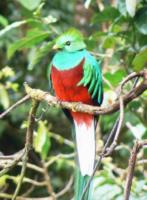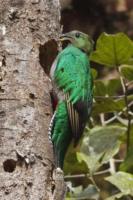 SKC Films Library SKC Films Library |
| SKC Films Library >> Science >> Zoology >> Birds >> Order Trogoniformes |
| Resplendent Quetzal [ket' sal] Pharomachrus mocinno [far uh mak' ruhs mO' sin nO] Description This bird's golden-green iridescence, long and flowing uppertail coverts, acute head crest, and contrasting deep red, black, and white plumage easily distinguish it from all other birds in its range. Although males are much more colorful than females, both sexes equally deserve the name "resplendent." The upperparts, head, neck, and chest of an adult male are iridescent or golden green; the green may appear bluish in darker light. The lower breast, belly, and undertail coverts are bright red. The greater wing coverts are elongated with black at the ends, and the greater secondary and primary wing coverts and the six middle tail feathers are black, while the three outer tail feathers are white with black shafts and black or gray bases. The thigh feathers are black, with lower ones showing some green. The feathers on the head form a crest, from the forecrown to the rear of the head. The uppertail coverts, also green, are greatly elongated beyond the tail. The appearance of the female is duller and less dramatic. The crown, head, back, scapulars, wing coverts, rump, and uppertail coverts are iridescent, golden green. The crest feathers are less developed than the male. The uppertail coverts of the female do not extend beyond the tip of the tail. Belly and sides are mostly gray; undertail coverts are red. The tail is black, with the three outer tail feathers on both sides barred in white and black. The primaries are edged with buff, the throat is gray-brown, and the thighs are black with the gloss of green as in the male. The immature male is somewhat brighter and its bare parts appear the color of the adult male. The immature female is more bronzy to dull green than the adult female, and its bill is more yellowish. The resplendent quetzal is 15-16 inches long, not counting its tail, which is about 24 inches long on the male. It weighs 7-8 ounces. Distribution and Habitat This species of quetzal is found from southern Mexico through Central America into Panama. It prefers damp mountain forests, and is most active in the canopy and edges. It may survive in heavily deforested areas, but only if there are still woods with adequate feeding and nesting trees. Reproduction During mating season (March to June, depending on location), male quetzals grow twin tail feathers that form a train up to three feet long. Both parents work together to either carve a nest hole out of a decaying trunk or to enlarge an existing hole made by a woodpecker, toucan, or other animal. They depend on finding dead wood because their beaks and claws cannot penetrate live wood. The female then lays 1 to 2 light blue eggs, which are incubated by both parents for 18 days. Both parents also share in the feeding of chicks. Young quetzals can fly at about three weeks of age, but males do not begin to grow their long tail plumes for three years. Diet Like all other quetzals, the resplendent quetzal feeds primarily on fruits, with the vast majority of the preferred fruits being in the avocado and fig families, although it will occasionally take insects or lizards, especially to feed young. Scientific Classification phylum Chordata |
| SKC Films Library
>> Science
>> Zoology >> Birds >> Order Trogoniformes This page was last updated on June 14, 2017. |

